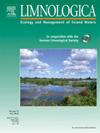模拟水库对浮动光伏系统的不同环境响应
IF 2
4区 环境科学与生态学
Q2 LIMNOLOGY
引用次数: 0
摘要
浮式光伏(FPV)系统正在成为世界范围内大规模清洁能源生产的一种有前途的战略。然而,通过改变关键的物理驱动因素,如太阳辐射和风混合,FPV装置也可能对湖泊和水库产生意想不到的后果。鉴于全球淡水系统的广泛多样性,了解FPV部署对环境反应的方向和程度的一致性对于知情的监管监督和可持续能源发展至关重要。在这里,我们使用基于过程的模型来模拟FPV覆盖对美国11个水库的影响。这是第一次使用横向平均2D过程建模框架进行多油藏分析,系统地评估了不同气候和形态背景下的FPV影响,从而可以直接比较系统之间响应的幅度和方向。具体来说,我们评估了(1)地表和流出温度的变化,(2)温跃层深度的变化,(3)水柱稳定性的变化,(4)溶解氧浓度的变化,以及(5)温暖和冷水鱼类的潜在适宜栖息地可用性的变化。我们通过迭代方法量化了这些响应变量的变化,该方法模拟了FPV覆盖率的增加,并将其与参考条件进行了比较。我们总结了冬季(1 - 2月)和夏季(7 - 8月)的反馈。正如预期的那样,我们的模拟表明,FPV覆盖范围的增加持续地冷却了地表水,改变了热分层模式,但这些变化的幅度和环境影响在不同的水库之间有所不同。值得注意的是,更大的植被覆盖度导致水生物种生境适宜性的变异性增加,一些水库表现出明显的、有时是不同的响应。这些发现强调了在评估FPV影响时考虑当地环境背景的重要性。虽然大型FPV系统为减缓气候变化提供了潜在的好处,但它们的生态效应,特别是对热敏感的生物群的生态效应,需要对具体地点进行仔细的评估,以避免对当地淡水生物多样性造成意想不到的后果。本文章由计算机程序翻译,如有差异,请以英文原文为准。
Modeling diverse environmental responses of reservoirs to floating photovoltaic systems
Floating photovoltaic (FPV) systems are emerging as a promising strategy for large-scale clean energy production worldwide. However, by altering key physical drivers such as solar radiation and wind mixing, FPV installations may have also unintended consequences for lakes and reservoirs. Given the wide diversity of freshwater systems globally, understanding the consistency in direction and magnitude of environmental responses to FPV deployment is critical for informed regulatory oversight and sustainable energy development. Here, we used process-based models to simulate the effects of FPV coverage on 11 reservoirs across the United States. This is the first multi-reservoir analysis using a laterally averaged 2D process-based modeling framework to systematically evaluate FPV impacts across diverse climatic and morphometric contexts, enabling direct comparison of magnitude and direction of responses among systems. Specifically, we evaluated changes in (1) surface and outflow temperature, (2) thermocline depth, (3) water column stability, (4) dissolved oxygen concentrations, and (5) potential suitable habitat availability for warm- and cold-water fishes. We quantified changes in these response variables by an iterative approach that simulates increases in FPV coverage and compares them with reference conditions. We summarized responses for winter (January–February) and summer (July–August). As expected, our simulations show that increasing FPV coverage consistently cooled surface waters and altered thermal stratification patterns, but the magnitude and environmental implications of these changes varied among reservoirs. Notably, greater FPV coverage led to increased variability in habitat suitability for aquatic species, with some reservoirs exhibiting distinct and sometimes divergent responses. These findings underscore the importance of considering local environmental contexts when assessing FPV impacts. While large-scale FPV systems offer potential benefits for climate mitigation, their ecological effects, particularly on thermally sensitive biota, require careful site-specific evaluation to avoid unintended consequences to local freshwater biodiversity.
求助全文
通过发布文献求助,成功后即可免费获取论文全文。
去求助
来源期刊

Limnologica
环境科学-湖沼学
CiteScore
3.70
自引率
5.90%
发文量
64
审稿时长
3 months
期刊介绍:
Limnologica is a primary journal for limnologists, aquatic ecologists, freshwater biologists, restoration ecologists and ecotoxicologists working with freshwater habitats.
 求助内容:
求助内容: 应助结果提醒方式:
应助结果提醒方式:


